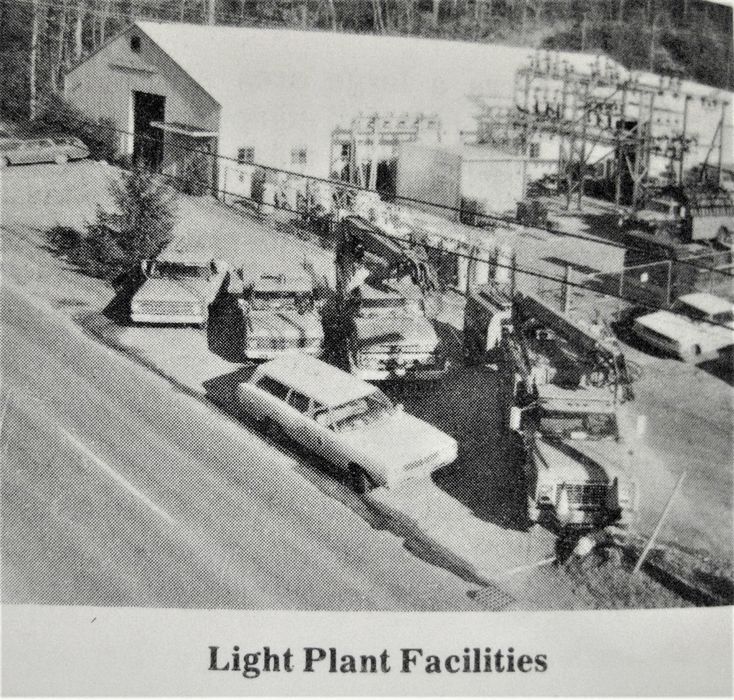Hingham Municipal Lighting Plant, MA, 1960-1963, Birdseye View Of New Ops Center
By Joe Maurath, Jr.; posted September 5, 2020
View Original: Click to zoom, then click to magnify (2238 x 2133) 1749KB

|
Expansion of light plant infrastructure and customers in the early 1960s in Hingham, MA unquestionably required new and additional resources. Here is a bird's eye view of their recently-built operations and engineering headquarters; the photo taken in the late 1960s. Accompanying the new building was a substation and switchyard entirely built with alunimum framing. It is believed there was only one other all-alunimum substation in existance at the time on the East coast. The Hingham station was ruggedly built. Entering it were two 23kv circuits from the New England Electric System with a switched take-off to a new industrial park and big shopping center a mile or two away. Primary metering was at the Hingham town line with telemetering so that the Hingham utility could receive vital, 24-hour-a-day ongoing electric load data at any time at their engineers' office. This information was "added together" into a totalizing recording meter at the former location. Several other points in town also sent additive meter "pulses" from imported energy-input locations in town. By the mid-1990s Hingham had completed its 13.8kv primary voltage program and the separate "input" stations were disconnected and eventually dismantled (including the one you see in the photo which was on Cushing Street). A 115kv double-circuit line and 13.8kv central substation built in the late 1980s radially sent primary voltage circuits all around town from the station's three huge transformers. Mercury vapor street lights were installed commencing during 1960 on well-travelled roads and dangerous intersections owing to record town population growth. The only other mercury street lights in town up until that time were those though downtown and the spanwire fixture across town at Queen Anne's Corner (the intersection of MA SR 228 and 53) (A photo of it will be added in the near future). Incandescent street lights continued to be installed in new neighborhoods through the 1960s with the town's belief that mercury vapor lighting kept trees "awake" at night, thus hindering their growth. This theory was never proven. Mercury vapor street lights were installed only on busy roads and on long mast arm brackets (or upon spanwire installations whereby the fixture was above the center of the roadway) until 1981. Otherwise, in most residential locations incandescent street lights were installed until late-1981.Commencing in 1982 the town converted all of their street lights to energy-efficient high-pressure sodium luminaires without any fears that they would affect adjacent tree foliage (no adverse effects were ever noted). Hurricane Donna whipped the town badly during September 1960. Since the town was well endowed with tall and historic trees, many of them that did not fall during the 1954 storms fell. Hendrix spacer cable construction already was standardized within the town's system and was widely used during reconstruction. Their first spacer insulators (1957-1960) were constructed of two pieces with a plastic bolt holding them together, along with rubber grommets inserted into them for securing each of the line wires. In 1960 it was decided to use transparent green ones (to blend with the adjacent foliage, still of the two-piece design). As far as I know Hingham was the only utility to order them in this color. Commencing in 1961 solid Hendrix spacers were standard; these were one-piece and medium to dark gray. The first bucket truck the Light Plant owned came into their possession by 1963. This eventually replaced the department's old ladder truck (from the late 1930s) that was always kept in perfect mechanical condition. Through the years it was the only way their street lighting servicer could replace bulbs, etc, for the numerous spanwire lights around town according to a retired employee. The facility you see was completed during the summer of 1963. The Light Plant moved into it during Labor Day weekend of that year. Their facilities formerly were at the town's public works headquarters, since the early 1930s. Lack of space and equipment/inventory overcrowding since the mid-1950s was an issue and eventually led to this move. The town's last one-room schoolhouse was transferred to the Light Plant in 1960 for a dollar. This quaint building, built in 1878, was somewhat converted to billing and administrative functions. Much of its charm and ambiance was retained and you could feel this as soon as you walked into the front door. The new substation and adjoining operations center (above); the larger and modernized office and town-wide system upgrades were among the many successful accomplishments by the (late) Clyde H. Curtis during an emerging demand for electricity throughout Hingham during the 1950s and 1960s. He was general manager from 1957 until 1981. He was responsible for the forementioned costly improvements that never were funded by rate increases nor loans, but via accrued reserved income according to town records; providing plenty of current for a growing town with rates and service dependability equal or superior compared to neighboring investor-owned utilities. Mr. Curtis was very proud of his service to Hingham and its Light Plant; [id=632013282] , Multiple (individually or group-controlled) 120V street lights were the norm for new installations in Hingham after about 1950. They were operated either via a separate "pilot" wire from a photoelectric lighting control that could handle 3,000 watts (over a dozen lights, depending on their wattage). Or from a photocontrol integral with the light fixture (after 1958). In 1963 the utility decided to no longer operate the three series street lighting loops that originated in adjacent Weymouth from a private utility dating back to 1890-1900. During 1963 any of the existing incandescent street lighting fixtures were converted to individual 120V photocontrols. Getting away from the old series wiring not only saved the town money but made the town's overhead wiring system much safer. |